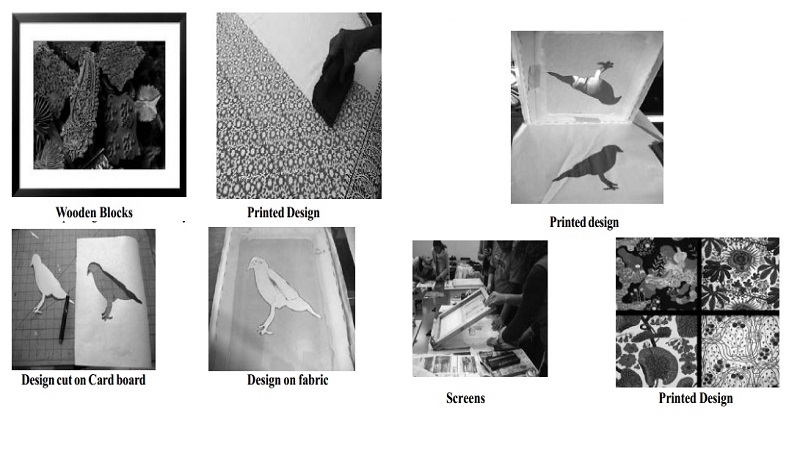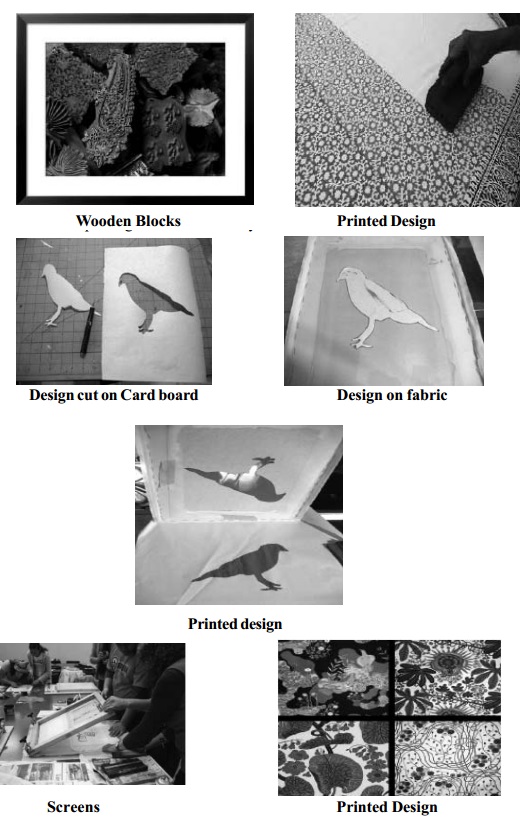Chapter: 11th 12th std standard Textiles And Dress Designing Cloth stitch Higher secondary school College practical steps methods Notes
Hand printing and Types - Block, Screen, Stencil Hand printing

Printing produces colourful effect on the fabrics Printing is application of colour in the form of a design. Printing can be done by hand or machine. The dyes used in printing are in the form of pastes.
Types of printing : Printing has been divided into,
A) Hand printing B) Machine printing
A) Hand printing
� Block Printing : Block printing was practiced by Chinese and Indians some two thousand years ago. Blocks are made of wood or wood and lino. The design is carved on line which is generally cut to a thickness of � inch. This cut piece of lino is struck to wooden piece of the same size. Many printers use only wooden blocks on which the design has been carved. These blocks are dipped in paste of colour and then pressed on the fabric, so that coloured pattern is produced on the fabric. First a block carrying the paste of one colour is stamped on the fabric and allowed to dry. Then another block carrying the paste of different colour is stamped over it to form the multi-coloured patterns. The process is repeated over the entire fabric surface to be printed.
It is a slow and costly process, uniform pressure is needed to transfer the colour. The intensity of colour cannot be uniform throughout.
� Stencil Printing : Stencil printing originated in Japan. Its high cost limits its use and importance. In this, printing, the design must be first cut in cardboard, wood or metal. The stencil may have a fine delicate design, or there may be large spaces through which a great amount of colour may be applied. A stencil design is usually limited to the application of one or two colours and generally used for narrow width of fabric like block printing. This method is very slow.
� Screen Printing : Originally, this technique was referred to as silk screen printing because the screens were made of fine, strong silk thread. Today they are also made of nylon, polyester, vinyl and metal. Screen printing is done with the use of either flat or cylindrical screens.

Each screen design may be drawn by hand and a coating of lacquer or other impermeable substance applied to all parts of the screen that are not part of its design. Today the design is photographed and a negative is used for each sensitized screen to opaque or block out, those areas not part of the screen's colour design. Each screen is then fitted into a wooden or metal frame.
The printing paste or dye is poured on the screen and forced through its unblocked areas onto the fabric with a rubber-edged squeeze. The frame is then raised and placed on the next section of the fabric and the operation is repeated until the entire length of the cloth is printed with that particular colour. This process must be repeated for each colour to be used in the design.
The hand screen printing is time-consuming and limited to relatively short lengths of 60 yards (58m) of fabric. Electronically controlled automatic machines can screen print long lengths of cloth at rates of upto 450 yards (400m) per hour.
Related Topics